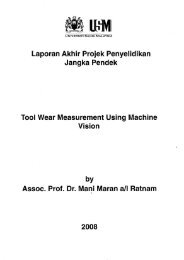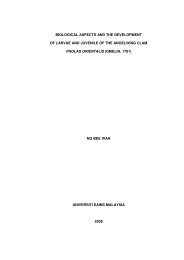microleakage in class ii composite restorations ... - ePrints@USM
microleakage in class ii composite restorations ... - ePrints@USM
microleakage in class ii composite restorations ... - ePrints@USM
You also want an ePaper? Increase the reach of your titles
YUMPU automatically turns print PDFs into web optimized ePapers that Google loves.
cl<strong>in</strong>ically undetectable passage of bacteria, fluids, molecules, or ions between a cavitywall and the restorative material applied to it (Kidd, 1976).Nanoleakage: occurs when the voids are so small that only water and some smallmolecules can pass. The difference between both types is somewhat arbitrary, s<strong>in</strong>ce bothmay occur simultaneously (Dorfer et al., 2000).Many different laboratory techniques have been used to demonstrate <strong>microleakage</strong>.These techniques <strong>in</strong>clude the use of bacteria, compressed air, chemical and radioactivetracers, neutron activation analysis, artificial caries technique, scann<strong>in</strong>g electronmicroscope, and perhaps the most common of all, dye penetration. Investigation ofleakage has been carried out both <strong>in</strong> vivo and <strong>in</strong> vitro, but the latter is more common. Invitro experiments can be divided <strong>in</strong>to two categories, one that uses a cl<strong>in</strong>ical simulationand the other one that is purely a test of the behavior of materials (Kidd, 1976).2.1.2 Factors Contribut<strong>in</strong>g to MicroleakageSeveral factors can affect the <strong>in</strong>tegrity of the tooth-restoration <strong>in</strong>terface and cancontribute to <strong>microleakage</strong>. Among these are:• Polymerization shr<strong>in</strong>kage and cavity configuration factor• Hydroscopic expansion• Light polymerization concepts and units• Thermal cycl<strong>in</strong>g and occlusal stresses2.1.2.1 Polymerization Shr<strong>in</strong>kage and Cavity Configuration FactorPhoto-polymerization is now a widely accepted <strong>in</strong>itiation mode for the cl<strong>in</strong>icalharden<strong>in</strong>g processes with a wide range of biomaterials <strong>in</strong>clud<strong>in</strong>g dental adhesives and<strong>restorations</strong>. The polymerization of dental <strong>composite</strong> res<strong>in</strong>s is <strong>in</strong>evitably accompaniedby shr<strong>in</strong>kage. Due to this, molecular densification dur<strong>in</strong>g the polymerization process of8
















